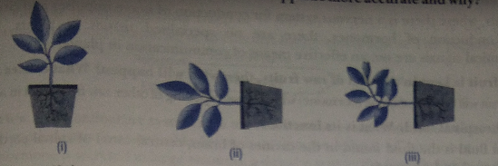Very Short Answer Questions - 1 Mark
Que 1. Mention the receptors for light and sound in animals.
Ans. Sense organs are called receptors. The receptor of light in animals is called photoreceptor. The receptor of sound in animals is called phonoreceptor.
Que 2. Which hormone regulates the concentration of sugar in the blood?
Ans. Insulin secreted by Islets of Langerhans of pancreas.
Que 3. Define 'reflex action."
Ans. Reflex action is a rapid, automatic response to a stimulus which is not under the voluntary control of the rain.
Que 4. Name few involuntary actions controlled by the hindbrain.
Ans. Involuntary actions controlled by hindbrain are vomiting, salivation and blood pressure.
Que 5. What is an axon?
Ans. It is a large, single, unbranched nerve fibre arising from the cyton. It carries impulses from cyton located in CNS to effectors.
Que 6. Why are roots called positively geotropic?
Ans. This is because the roots always grow towards the gravity of the Earth.
Que 7. What is the number of cranial nerves and spinal nerves in human beings?
Ans. There are 12 pairs of cranial nerves and 31 pairs of spinal nerves in human beings.
Que 8. Name the largest cell present in the human body.
Ans. Neuron
Que 9. Which part of central nervous system controls reflexes?
Ans. Spinal cord
Que 10. Name the part of neuron
(a) where information is acquired.
(b) through which information travels as an electrical impulse.
Ans. (a) Dendrite, (b) Axon.
Que 11. What will happen if intake of iodine in our diet is low?
Ans. (i) When iodine intake is low, release of thyroxine from thyroid gland will be less by which protein, carbohydrate and fat metabolisms will be affected.
(ii) A person might suffer from goitre in case of iodine deficiency in the body.
Que 12. Which hormone controls the metabolism of calcium and phosphorus in human beings?
Ans. Parathyroid hormone (parathormone)
Que 13. Name the hormone, the secretion of which is responsible for dramatic changes in appearance in girls and boys when they approach 10-12 years of age.
Ans. Oestrogen from the ovaries of girls and testosterone from testes of boys.
Que 14. Name two tissues that provide control and coordination in multicellular animals.
Ans. The two tissues that provide control and coordination in multicellular animals are nervous tissue and muscular tissue.
Que 15. Which hormone helps in lowering the level of blood glucose in human beings?
Ans. Insulin
Que 16. What do you understand by the sleep movement of plant organs?
Ans. Sleep movement in plants e.g., in flowers is to protect the reproductive organs from the cold. Hence, sepals and petals of saffron flower close at sunset and open up in the morning.
Que 17. In the figure below (i), (ii) and (iii), which appears more accurate and why?

Ans. Figure (i) is more appropriate because in a plant, shoots are negatively geotropic hence, grow upwards and roots are positively geotropic so they grow downwards.
Que 18. State the main function of abscisic acid in plants.
Ans. Abscisic acid slows plant growth and inhibits division of cells.

